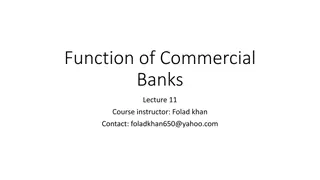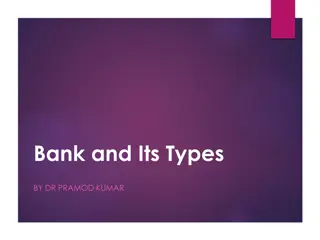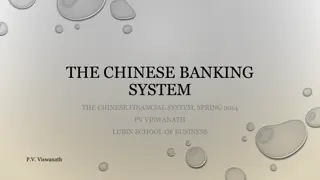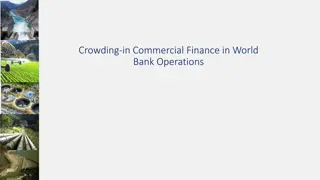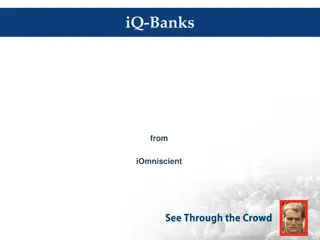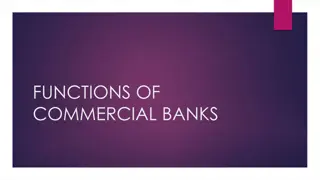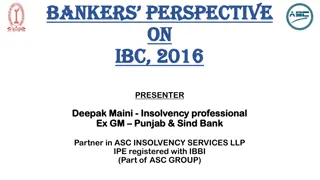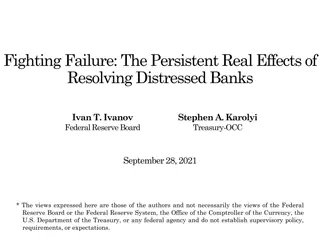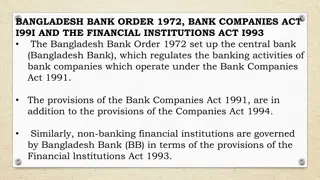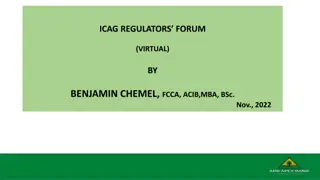Overview of Commercial Banks in the Financial Industry
Commercial banks play a crucial role in the financial industry by accepting customer deposits, providing loans, and facilitating the transmission of monetary policy. They differ from nonfinancial firms in their balance sheets, with assets mainly composed of loans and other financial assets. Regulated to ensure stability, commercial banks generate revenue from loans, investments, and other assets while facing risks like credit and liquidity risks.
Download Presentation

Please find below an Image/Link to download the presentation.
The content on the website is provided AS IS for your information and personal use only. It may not be sold, licensed, or shared on other websites without obtaining consent from the author. Download presentation by click this link. If you encounter any issues during the download, it is possible that the publisher has removed the file from their server.
E N D
Presentation Transcript
Commercial banks: industry overview Chapter 11
Commercial banks as a sector of financial institutions industry Depository institutions A significant proportion of their funds come from customer deposits.
Differences in Balance Sheets of Commercial Banks and Nonfinancial Firms Nonfinancial firms Commercial Banks Assets Liabilities and Equity Assets Liabilities and Equity Loans Deposits Deposits Loans Other financial assets Other liabilities and equity Other financial assets Other liabilities and equity Other nonfinancial assets Other nonfinancial assets Loans Commercial Banks Nonfinancial firms 3 Deposits
Role of commercial banks to efficient functioning of financial institutions Play a key role in the transmission of monetary policy for the central bank to the rest of the economy As deposits are significant component of money supply
Role of commercial banks to efficient functioning of financial institutions Economy benefits from the efficiency of the payment services Offer maturity intermediation
Why are CBs regulated? To protect against disruptions to the services they perform
Commercial Bank Assets Loans generate revenue for banks commercial and industrial loans are declining because of nonbank substitutes such as commercial paper mortgages are increasing in importance Investment securities generate revenue and provide banks with liquidity Cash assets are held to meet reserve requirements and to provide liquidity Other assets include premises and equipment, other real estate owned, etc. 7
Commercial Bank Risks from Assets Commercial banks face unique risks because of their asset structure credit (default) risk is the risk that loans are not repaid liquidity risk is the risk that depositors will demand more cash than banks can immediately provide interest rate risk is the risk that interest rate changes erode net worth credit, liquidity, and interest rate risk all contribute to a commercial bank s level of insolvency risk Dr. Lakshmi Kalyanaraman 8
Commercial Bank Liabilities Transaction accounts are the sum of noninterest-bearing demand deposits and interest-bearing checking accounts interest bearing deposit accounts are called negotiable order of withdrawal (NOW) accounts Household (retail) savings and time deposits have been declining in recent years because of MMMFs passbook savings accounts retail time deposits Large time deposits negotiable CDs are fixed-maturity interest-bearing deposits that can be resold in the secondary market Dr. Lakshmi Kalyanaraman 9
Commercial Bank Liabilities & Equity Non-deposit liabilities fed funds purchased repos notes and bonds Minimum levels of equity capital are required by regulators to act as a buffer against losses common and preferred stock surplus or additional paid-in capital retained earnings Dr. Lakshmi Kalyanaraman 10
Off-Balance-Sheet Activities Commercial banks engage in many fee-related activities that are conducted off the balance sheet guarantees such as letters of credit future commitments to lend derivative transactions (e.g., futures, forwards, options, and swaps) Off-balance-sheet asset when an event occurs, this item moves onto the asset side of the balance sheet or income is realized on the income statement Off-balance-sheet liability when an event occurs, this item moves onto the liability side of the balance sheet or an expense is realized on the income statement Dr. Lakshmi Kalyanaraman 11
Off Balance Sheet Activities Earn additional fee income to complement declining margins on traditional lending business Avoid regulatory costs or taxes since reserve requirements and deposit insurance premiums are not levied Involve risks that add to overall insolvency exposure Dr. Lakshmi Kalyanaraman 12
Other fee generating activities Trust services: hold and manage assets for individuals or corporations Correspondent banking: Services to other banks that do not have staff resources check clearing and collection, foreign exchange trading, hedging services and participation in large loan and security issuances Dr. Lakshmi Kalyanaraman 13
Economies of scale refer to the degree to which a firm s average unit costs of producing financial services fall as its output of services increase diseconomies of scale occur when the costs of joint production of FI services are higher than they would be if they were produced independently Economies of scope refer to the degree to which a firm can generate cost synergies by producing multiple financial service products X efficiencies refer to cost savings due to greater managerial efficiency Dr. Lakshmi Kalyanaraman 14
Revenue Economies of Scope Acquiring an FI in a growing market may produce new revenues Acquiring bank s revenue stream may become more stable if the asset and liability portfolio of the acquired (target) institution exhibits different product, credit, interest rate and liquidity risk characteristics from the acquirer s. Expanding into markets that are less than fully competitive offers an opportunity for revenue enhancement. Dr. Lakshmi Kalyanaraman 15
Retail banking is consumer-oriented residential and consumer loans are funded by accepting small deposits community banks specialize in retail banking Wholesale banking is commerce-oriented commercial and industrial loans are often funded with purchased funds regional or superregional banks engage in a complete array of wholesale banking activities money center banks rely heavily on non deposit or borrowed sources of funds often borrowed in the federal funds market Dr. Lakshmi Kalyanaraman 16
Because larger banks generally lend to larger corporations, their interest rate spreads and net interest margins are usually narrower than those of smaller banks interest rate spread is the difference between lending and deposit rates net interest margin is interest income minus interest expense divided by earning assets Large banks tend to pay higher salaries and invest more in buildings and premises than small banks Large banks tend to diversify their operations more and generate more noninterest income than small banks Dr. Lakshmi Kalyanaraman 17
Wholesale Banking Services Bank s ability to provide cash management or working capital services Need for cash management 1. Corporate recognition that excess cash balances result in a significant opportunity cost due to lost or forgone interest 2. Corporate managers need to know cash or working capital positions on a real-time basis. Dr. Lakshmi Kalyanaraman 18
Wholesale Banking Services Controlled disbursement accounts Account reconciliation Lockbox services Electronic lockbox Funds concentration Electronic funds transfer Check deposit services Electronic initiation of letters of credit Treasury management software Electronic data interchange Facilitating business-to- business e-commerce Electronic billing Verifying identities Assisting small business entries in e-commerce Dr. Lakshmi Kalyanaraman 19
Retail Banking Services Retail customers demand efficiency and flexibility in their financial transactions Automated teller machines (ATMs) Point-of-sale (POS) debit cards Preauthorized debits and credits Paying bills via telephone Online banking Smart cards (stored-value) cards Internet banking complements existing business for already existing banks some new internet-only banks have no brick and mortar Dr. Lakshmi Kalyanaraman 20
Regulators http://www.sama.gov.sa/sites/samaen/Bankin gControl/Pages/Home.aspx Dr. Lakshmi Kalyanaraman 21
International Commercial Banking Advantages of international expansion Risk diversification Less integrated the economies of world are, the greater is the potential for earnings diversification through international expansion Economies of scale Potential to lower the average operating costs by expansion Innovations extra returns from new product innovations if it can sell such services like securitization, caps, floors and options Funds source cheapest and most available sources of funds Customer relationships maintain contact with and service the needs of domestic multinational corporations Regulatory avoidance expand in low-regulatory, low-tax countries to lower its net regulatory burden and increase potential profitability Dr. Lakshmi Kalyanaraman 22
International Commercial Banking Disadvantages of international expansion information and monitoring costs are generally higher in foreign markets foreign assets may be subject to nationalization or expropriation by host country governments the fixed costs of establishing foreign organizations may be extremely high Dr. Lakshmi Kalyanaraman 23



